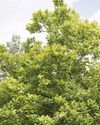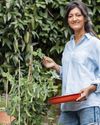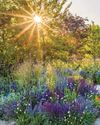
I get huge pleasure from watching the birds at Longmeadow. I put out food by the kitchen window and love how this becomes incorporated into the daily rounds of chaffinches, tits, robins, blackbirds, thrushes and occasional blackcaps. But nothing I grow gives me as much pleasure as the arrival of the house martins and swallows in April, and their presence throughout summer. The house martins nest above our bedroom window and their chittering wakes me at dawn.
I lie watching their incredible aeronautical display as the parents and assistant adults swoop and wheel to the nests tucked under the eaves. By the time they're feeding their third brood, there can be scores of birds cutting arcs that interweave within millimetres of each other.
The swallows nest in our sheds and fly lower, faster and more direct - Spitfires to the house martins' Hurricane. They start to thin out around the middle of September until one morning I find that they've all disappeared, leaving the sky and garden empty. It's an annual bereavement only made tolerable by the incredible heart lurch when the first exhausted bird comes bobbing back in the middle of April. The garden is as full of birds as plants and I relish this, both for their presence and the benefits they bring to the garden.
Healthy habitats
Every garden has some birds, but some have more than others, and the longer that I garden, the more I am made aware that the number of birds in your garden is as good a measure of its health as anything else. If a garden can attract and support lots of bird life, it must also be rich in the insects and seeds that they need to sustain them, which in turn implies a rich and varied ecology in your own backyard. In other words, birds are a barometer of everything that we do right in our gardens.
هذه القصة مأخوذة من طبعة January 2023 من Gardeners World.
ابدأ النسخة التجريبية المجانية من Magzter GOLD لمدة 7 أيام للوصول إلى آلاف القصص المتميزة المنسقة وأكثر من 9,000 مجلة وصحيفة.
بالفعل مشترك ? تسجيل الدخول
هذه القصة مأخوذة من طبعة January 2023 من Gardeners World.
ابدأ النسخة التجريبية المجانية من Magzter GOLD لمدة 7 أيام للوصول إلى آلاف القصص المتميزة المنسقة وأكثر من 9,000 مجلة وصحيفة.
بالفعل مشترك? تسجيل الدخول

A new plot for tasty crops
Taking on a new allotment needn't be hard work. By simply following a few easy tips you can have bumper crops in no time, just like Alessandro Vitale

We love July
July is an island floating between the joy of June and the slightly fatigued month of August. It's a grown-up month: the year has shrugged off its adolescent exuberances, the weather is (hopefully) warm enough for ice cream to be one of your five a day, the sea should be swimmable without (too much) danger of hypothermia and thoughts will be of holiday shenanigans and family barbecues. School's out this month, the next tranche of glorious summer colour is washing across our borders and it's my birthday. Lots of reasons to give three rousing cheers for July!

YOUR PRUNING MONTH
Now, at the height of summer, Frances Tophill shows how to boost your plants' health and productivity with a timely cut

Hassle-free harvests
Flowers are out in abundance this month and for Jack Wallington, many of these blooms make delicious, low-effort pickings

Bite-sized bounties
Glorious doorstep harvests can easily turn into gluts, so let Rukmini Iyer's recipes help you savour every last bit

Upcycled outdoor living
Create unique and stylish garden features for minimal cost using reclaimed materials and simple DIY skills. Helen Riches shares four step-by-step projects and more inspiring eco tips

Secrets of a COLOURFUL GARDEN
Buildings and landscapes can play a vital role in supercharging your space, as Nick Bailey demonstrates

Greening up a city balcony
Looking for sustainable, small-space gardening ideas? Take inspiration from Oliver Hymans' transformed balcony garden in north-east London - now a lush, green haven for humans and wildlife

The dry and mighty garden
As we adapt our gardens to a more volatile climate, Alan Titchmarsh reveals how to create a drought-tolerant plot and picks his top plant performers

Nature knows best
Carol Klein explains how to choose plants for specific growing conditions, based on what has naturally adapted to thrive there